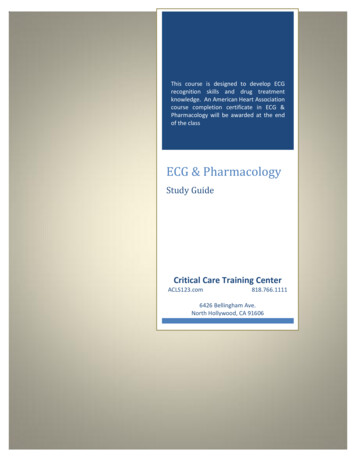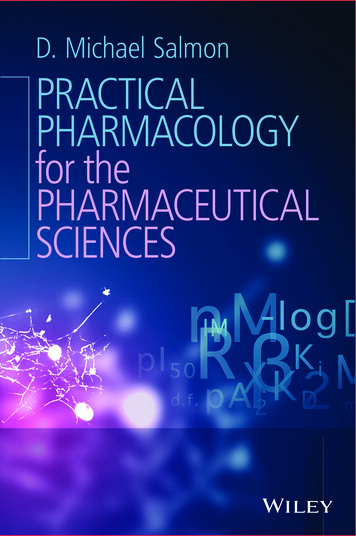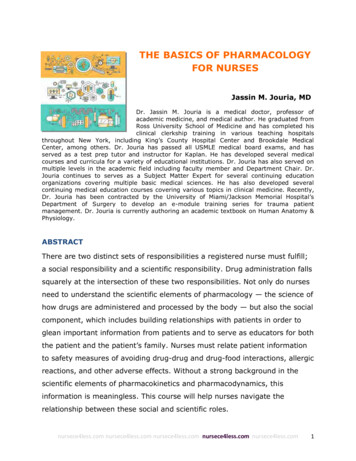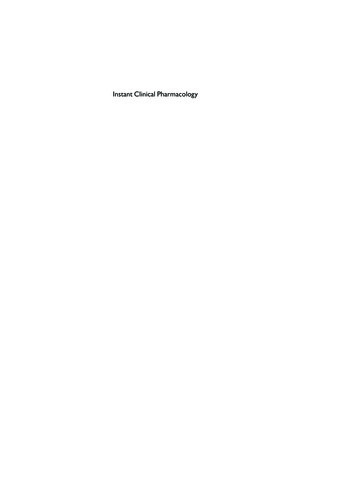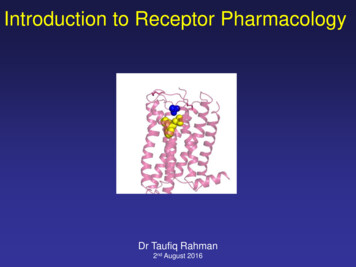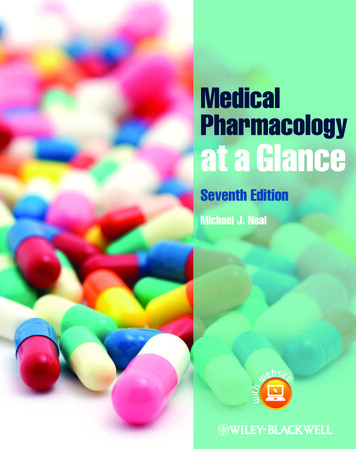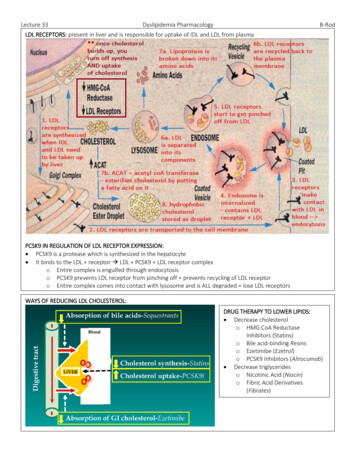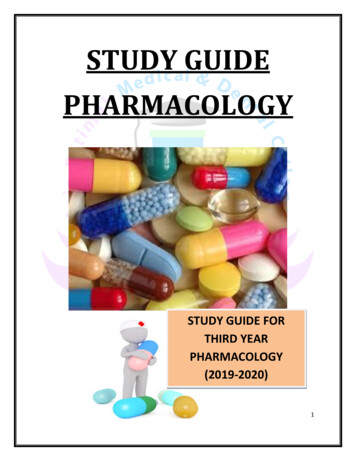
Transcription
STUDY GUIDEPHARMACOLOGYSTUDY GUIDE FORTHIRD YEARPHARMACOLOGY(2019-2020)1
TABLE OF CONTENTS1CONTENTSPharmacology Department Team- AFMDCPage No.32Introduction to Pharmacology43Teaching and Learning Methodologies5456786Time Table and Time lineAssessment MethodologiesToS Theory PaperToS OSPE StationsLearning ObjectivesTextbooks, References and On-line Resources678910292
PHARMACOLOGY DEPARTMENT TEAM - AFMDCPositionsHead of DepartmentAssistant ProfessorAssistant ProfessorDemonstratorPharmacistNameProf. Dr. Farida Qadir (MBBS, M Phil, PhD)Dr. Sarwat Jahan (MBBS, M Phil)Dr. Iram Akram (MBBS, M Phil)Dr. Humna Yasir (MBBS)Ramsha Abbas (Pharm D, M Phil)Computer operatorLaboratory attendantMr. Aamir HussainMr. Habib ur Rahman3
INTRODUCTION TO PHARMACOLOGYPharmacology is one of the basic sciences that forms the foundation formedical practice. It describes how drugs interact with the human body at themolecular, cellular, and tissue levels to elicit their effects (pharmacodynamics)and how body absorbs, distributes, metabolizes and eliminates drugs(pharmacokinetics). General concepts of pharmacology are grounded in thefoundational sciences of physiology, genetics, biochemistry and anatomy.Pharmacology forms a bridge between the foundational and clinical scienceswhere the application of the principles of pharmacology becomes thefoundation for therapeutics. The value of pharmacology is to ensure ascientific basis for therapeutic decisions and the evaluation of benefit versusrisk based on an understanding of the pharmacodynamics andpharmacokinetics of drugs.Learning Outcomes: Education in pharmacology is divided into two phases.The first phase includes the development of a solid knowledge base of themajor classes of therapeutic agents. In the second phase, students are exposedto clinical situations in which they explain the pharmacological basis for theirdrug of choice, what possible adverse effects to anticipate and common druginteractions in case of polypharmacy. This finally leads an understanding ofthe scientific methods of evaluating the benefits and risks of drugs which isthe core concept of pharmacology as a foundational science.Goals of Pharmacology: The broad goal of the teaching of Pharmacology toundergraduate students is to inculcate a rational and scientific basis of use oftherapeutic agents in treatment of diseases. To instill the practice of criticalthinking and develop interest in learning through the latest evidence basedtreatment guidelines and research into new pharmaceutical agents.4
TEACHING/ LEARNING METHODOLOGIESThe comprehensive teaching plan is designed according to the UHS andPM&DC syllabi and guidelines to direct the students towards achievement ofthe desired goals. Lectures: This comprises of lecture sessions in which the instructor usestraditional teaching techniques using multimedia interspersed withinteractive sessions to help students acquire clear concepts of the learningobjectives. Tutorials: The students will also be exposed to small group discussionsduring the tutorial sessions in which they will come prepared after havingread through the topics covered in the lectures. The learning objectives forthe tutorial sessions in the week to follow will be posted on the departmentnotice board on Thursday–Friday of the preceding week to give studentsample time during the weekend to thoroughly prepare the topic.Instructors will clarify and explain any difficulties in understanding theconcepts and identify and fill any gaps in knowledge. The last 15 minutes ofeach class will comprise of a small quiz to help assess how much thestudent has benefited from the discussion. 5 marks will be allocated forperformance/participation during discussions and 5 marks for the quiz. Practical Sessions: The course of the practical sessions has been designedin line with UHS/PMDC syllabi. In the portion of experimentalpharmacology, some of the keys pharmacological concepts learnt in theoryclasses will be demonstrated and performed using animal experiments.The students will also be exposed to common clinical case scenarios inwhich they will learn to diagnose the case and write a suitable prescriptionbased on the recent treatment guidelines and also keeping in view thedoses required, the duration of treatment and drug interactions in mind.The pharmacy section of the course will enable students to prepare anddispense some commonly used solutions, creams, ointments and lotions. Class Discussions: A 90 minutes time slot every month has been allocatedto class discussion where the students are given a feed-back on theirmonthly test performance. They are guided on the proper approach tosolving MCQs and short essay questions. Whenever required students are5
divided in small groups to help, guide and explain to each other someallocated topics. Instructors are present guide the course of discussions.Time-Table 3rd Year esdayWednesdayThursdayFridayMonthly test(3rd ion13:0014:0014:00-15:00JummahbreakSelf-studyTIME LINE for SYLLABUS COMPLETIONTHIRD YEAR eneralPharmacologyAutonomicNervous SystemCardiovascularsystemGITRespirationCentral NSChemotherapyNSAIDsDrugs affectingbonesBlood DrugsEndocrinesWinter breakSummer vacationsRevision & Send up prepSend up examLectures6
ASSESSMENT METHODOLOGIESRegular assessments both formative and summative are made throughout theyear in order to evaluate achievement of learning objectives, identifyweaknesses and difficulties and improve instructional designs. Theassessment tools are based on table of specifications from UHS in order togive students ample practice and confidence while attempting the final exams. Short quizzes comprising multiple short questions and brief answers atthe end of each tutorial class. Evaluation of participation/performance during the tutorial sessions. Monthly tests of 90 minutes duration, conducted every month on theunit covered previously. This will be on the MCQ and short essay format. Send up Exams (theory) at the end of the academic year covers all theunits included in the syllabus. It is a mock exams designed on thepattern of the final professional exams. Send up Exams (practical) are conducted following the send uptheoretical exams and comprise of unobserved OSPE (7 stations),performance of observed experimental and pharmacy practical and anoral viva test.Marks allocated during the send up tests follow the same pattern ofdistribution as provided in ToS of UHS. Attaining least 50% marks aremandatory in order to qualify for admission to UHS final exams. Students are required to maintain a Practical Journal ofPharmacology which they complete during the practical classes andhave it checked and signed by the instructor. 5 marks are allocated tothe journal.Calculation of Internal Assessment Monthly assessment (100marks) 15 marks for tutorials 10 marks forattendance 75 marks monthly test Internal assessment sent to UHS is for 30 marks which includes 12(40%) marks calculated from average monthly assessment results 18(60%) marks calculated from send-up exam results.7
UHS 3rd Professional ExamsToS Pharmacology (Theory Paper)TopicGeneral PharmacologyANS and Neuromuscular BlockersCVS, Diuretics and Blood DrugsCNSAutacoids, NSAIDs, Antigout, AntirheumaticAntimicrobial and antibiotics in general useAntimycobacterial, Antiprotozoal,AntihelminthAntineoplastic, Antiviral, Antifungal,Dermatological drugsGITRespiratoryEndocrine, UterusSEQs01011.501010101MCQs0505 0110060610060.5050.50.501030206TotalTotal 6510Total SEQs 10 X 7 marks each 70 marks, Time 2 hours (12 minutes eachquestion). Attempt all questions. All questions carry equal marks.Total MCQs 65 X 01 mark each 65 marks. Time 1 hour, Type 1 best of fiveUHS Marks Distribution for Theory ExamsSEQs10 X 7 70Theory Total 150MCQsInternal Assessment1 X 65 65 158
ToS FOR OSPE (UNOBSERVED STATIONS)Pharmacology & Therapeutics (OSPE)OSPE Stations & MarksStationNo.123456712Station CategoryMarksNon-Observed Stations (Total Marks-35)Pharmacy Calculations5Dose Calculations5Abbreviations/Theory Related Questions5Prescription Writing5P-Drug5Abbreviations/Theory Related Questions5Biostatistics5Observed Stations (Total Marks-35)Experimental Pharmacology (Including20Table Viva)Pharmacy Practice (Including Table Viva)15Time(Min.)4444444UHS Marks Distribution for Practical ExamsPractical Total observed)assessmentJournalPharmacy Experimental303057 stations X 5 15 marks20 marks15 35 marks9
LEARNING OBJECTIVES OF PHARMACOLOGYTHIRD YEAR M.B.B.SUNIT I GENERAL PHARMACOLOGYPHARMACOKINETICS1. Topic : Routes of Drug Administration 1.2.3.4.5.6.At the end of this session you should be able to:Define pharmacokinetics and pharmacodynamicsList the pharmacokinetic drug parametersExplain the purpose of studying pharmacokinetics of drugsDefine first-pass effect and explain the sites of first-pass metabolismClassify the different routes of drug administrationExplain the advantages and disadvantages of the different routes with few examples ofdrugs administered by these routes2. Topic: Drug Absorption 1.2.3.4.5.6.7.8.At the end of the session students should be able to:Define bioavailabilityCalculate bioavailabilityDefine bioequivalence, therapeutic equivalence, pharmaceutical equivalenceExplain the physical and chemical characteristics of drugs that modifyabsorption/bioavailability.Discuss physiological and pathological factors that modify drug absorption/bioavailability.Explain the effect of drug ionization on absorption, distribution and excretion of drugsDefine pKa value of drugs and explain the relationship of pH and pKa to drug ionizationDescribe the phenomenon of “ion-trapping”. Give some examples of its clinical implications3. Topic: Drug DistributionAt the end of the session you should be able to:Define drug distribution and apparent volume of distributionCalculate VdExplain the different body compartments and pattern of drugs distribution between thesecompartments.4. Explain the factors that determine the distribution of a drug5. Describe plasma protein binding of drugs and its significance in drug interaction6. Define drug redistribution with examples 1.2.3.4. Topic: Drug Metabolism At the end of the session students should be able to:1. Define drug elimination, drug biotransformation10
2.3.4.5.6.7.Describe the purpose of drug metabolismList the sites of drug metabolismExplain the stages of drug metabolismDiscuss the role of CYP-450 enzyme system in drug biotransformationDescribe the factors that modify biotransformation of drugsExplain hepatic enzyme induction, inhibition and genetic polymorphism and their discusstheir clinical implication5. Topic: Drug Excretion 1.2.3.4.5.At the end of the session students should be able to:Define drug excretionList routes of excretionExplain processes involved in renal excretion, Ion trapping, High and low renal clearanceExplain: Biliary excretion, Pulmonary excretion, Mammary excretionDiscuss drug Clearance6. Topic: Clinical Pharmacokinetics 1.2.3.4.5.6.7.8.9.10.11.12.At the end of this session students should be able to:Explain 1st order and zero-order elimination kineticsDraw graph of plasma concentration versus time for zero and 1st order eliminationCompare 1st order and zero-order elimination kineticsCalculate change in plasma concentration of drugs at various times after administrationDefine half-life of a drug and explain the relationship between t1/2, Vd and CLCalculate the half-life of a drug from t1/2 and Vd valuesName conditions that can increase or decrease t1/2List the different types of drug dosage regimensDefine steady-state drug concentration (Css)Explain the effect of change in rate of administration on CssCalculate loading dose and maintenance dose of drugsExplain the purpose of giving loading dosePHARMACODYNAMICS7. Topic: Drug ReceptorsAt the end of this session students should be able to:Define pharmacodynamics and explain the purpose of studying pharmacodynamics of drugsEnumerate drug receptor super families with examples of each typeExplain details of signal transduction mechanisms of G-protein coupled receptors, ligandgated ion channels, intracellular receptors and enzyme linked receptors4. Explain: Affinity, efficacy, agonists, antagonists5. Describe different types of agonists6. Describe types of drug antagonists with examples 1.2.3.8. Topic: Quantitative Pharmacodynamics At the end of this session students should be able to:11
1.2.3.4.5.6.7.8.9.Explain the two types of Dose-Response-CurvesExplain the information obtained from graded D-R-C and quantal D-R-CsDefine drug potency and explain its importanceCompare the potency and efficacy of drugs from their dose-response curvesRecognize the D-R-C of different types of drug agonistsRecognize the D-R-C of agonist in presence of reversible and irreversible antagonistsDefine and calculate therapeutic index and explain its importanceDefine therapeutic window and explain its importanceExplain the concept of spare receptors.9. Topic: Adverse Drug Reactions At the end of this session students should be able to:1. Explain the terms: drug tolerance, tachypylaxis, anaphylaxis and idiosyncratic drugreactions with examples of each.2. Discuss teratogenic effects of drugs3. Explain drug dependence and drug withdrawal effects10.Topic Drug InteractionsAt the end of this session students should be able to:Define drug interaction and explain the consequences of drug interactionsClassify the pharmacokinetic and pharmacodynamics drug interactionsExplain with examples: drug synergism, potentiation, additive effect and antagonismDiscuss with examples pharmacokinetic drug interactions at the level of absorption,distribution, metabolism and excretion5. Discuss physiological, chemical and pharmacological drug antagonism.6. Give some examples of drug-food interactions 1.2.3.4.UNIT II AUTONOMIC NERVOUS SYSTEM1. Topic: Introduction to ANSAt the end of this session students should be able to:Describe the organization of the nervous systemName the location of adrenergic and cholinergic neurons.Explain the neurotransmitters in ANS and how norepinephrine and acetylcholine aresynthesized, released and degraded4. Explain how drugs can influence synthesis, storage, release and metabolism of acetylcholineand norepinephrine5. Classify the cholinergic receptors and explain their location, signal transduction mechanismand effect of activation of these receptors6. Classify the adrenergic receptors and explain their location, signal transductionmechanisms and effects of activation of these receptors 1.2.3.CHOLINERGIC DRUGS2. Topic: Cholinergic Agonists At the end of this session students should be able to:12
1.2.3.4.5.6.Classify cholinergic agonist drugsDescribe the systemic effects of cholinergic agonistsDescribe the uses, adverse effects and contraindications to use of cholinergic agonistsCompare physostigmine and neostigmineDescribe the signs and symptoms and treatment of organophosphorus compound poisoningName drugs used in treatment of glaucoma, Alzheimer’s disease and myasthenia gravis andthe rationale for their use in these conditions3. Topic: Muscarinic Receptor Blocking Drugs At the end of this session students should be able to:1. Classify cholinergic antagonists with examples of selective and some nonselectivemuscarinic blockers.2. Describe the mechanism of action of muscarinic blocking drugs3. Describe the systemic effects of antimuscarinic drugs4. Name the uses of antimuscarinic drugs and know the rationale for these indications.5. Describe adverse effects of muscarinic antagonists6. Describe the signs and symptoms and treatment of atropine poisoning4. Topic: Nicotinic Receptor Blockers(Neuromuscular Blocking Drugs) 1.2.3.4.5.6.7.At the end of this session students should be able to:Classify the neuromuscular blocking agents (NMBAs).Discuss the mechanism of action of competitive and depolarizing NMBAs.Mention uses of NMBAsDiscuss the adverse effects of competitive and depolarizing NMBAsExplain malignant hyperthermia and prolonged apnea produced by succinylcholineDiscuss drug interactions of NMBAsName the centrally acting muscle relaxants, their mechanism of action and uses5. Topic: Nicotinic Receptor Blockers(Ganglion Blocking Drugs) At the end of this session students should be able to:1. Classify ganglion blockers and explain their systemic effects, use and adverse effectsADRENERGIC DRUGS6. Topic: Adrenergic Agonists 1.2.3.4.5.At the end of this session students should be able to:Classify sympathomimetic drugs based on their chemical structureCompare catecholamines and noncatecholaminesClassify sympathomimetic drugs based on receptor affinity with examples of each groupDescribe the systemic effects of epinephrine, norepinephrine, isoproterenolCompare the effects of epinephrine, norepinephrine and isoproterenol on cardiovascularsystem13
6. Discuss the clinical uses of epinephrine, norepinephrine and isoproterenol with rationalefor their use7. Discuss the adverse effects of epinephrine and contraindications to its use8. Describe the dose-dependent effect of dopamine on cardiovascular system and list theclinical indications for use of dopamine9. Describe the important characteristics of – selective α1 agonists, selective α2 agonist(clonidine), selective β1 agonist, selective β2 agonists10. Describe the important features of indirectly acting sympathomimetic drugs –amphetamine, ephedrine11. Discuss shock – types and management7. Topic α-Blocking Drugs 1.2.3.4.5.At the end of this session students should be able to:Classify blocking drugsDescribe systemic effects of blockersList uses of blockers and give the rationale for use in these conditionsExplain adverse effects of blockersName contraindications to use of α-blocking drugs8. Topic β-Blocking Drugs 1.2.3.4.5.6.At the end of this session you should be able to:Classify β blocking drugsDescribe the systemic effects of β blockersExplain the uses of β blockersExplain the beneficial effects of β blockers in hypertension, cardiac failure and arrhythmiasDescribe the adverse effects of β blocking drugsExplain the conditions in which β blockers are contraindicated/ used with caution9. Topic Adrenergic Neuron Blockers At the end of this session you should be able to:1. Name the adrenergic neuron blocking drugs2. Describe important characteristics of: α methyl dopa, reserpine, guanetedine, bethanedineUNIT III CENTRAL NERVOUS SYSTEM1. Topic: Introduction to CNSAt the end of this session students should be able to:Define neurotransmitters, neuromodulators, neurotropic agents.List the criteria defining a neurotransmitterName the important excitatory and inhibitory neurotransmitters in brain and describe theirmechanisms of action4. Relate the disturbances in neurotransmitters to disease conditions5. Describe the effects of CNS stimulant and CNS depressant drugs 1.2.3.2. Topic: Anxiolytic, Sedative, Hypnotic Drugs14
At the end of this session students should be able to:1. Classify major anxiolytic, sedative, hypnotic drugs2. Describe the mechanism of action of benzodiazepines, barbiturates, buspirone andzolpidem, zaleplon3. Describe the systemic effects of benzodiazepines and relate these to clinical uses ofbenzodiadepines4. Compare benzodiazepines with barbiturates5. List the important uses of sedative, hypnotics and their adverse effects6. Describe the treatment of benzodiazepine, barbiturate overdose3. Topic: Local AnestheticsAt the end of this session students should be able to:Classify local anestheticsTabulate the differences between esters and amides groupExplain the mechanism of action of local anestheticsDiscuss the factors affecting onset and duration of action of local anesthetics (with emphasison effect of pH and pKa values)5. Discuss local anesthetic toxicity6. Explain the techniques for administration of local anesthetics 1.2.3.4.4. Topic: General Anesthetics 1.2.3.4.5.6.7.8.9.At the end of this session students should be able to:Classify of general anestheticsExplain the mechanism of action of general anestheticsList the properties of an ideal inhalation anestheticDiscuss the factors governing the onset and duration of general anesthetics with particularreference to blood:gas partition coefficient and oil:gas partition coefficientDefine MAC value and discuss the importance of this valueList the pre-anesthetic medications and give the rationale for their useExplain the systemic effects and adverse effects of the inhalation and IV general anestheticsCompare halothane and nitrous oxideDefine neuro-lept anesthesia and conscious sedation5. Topic: Antidepressant Drugs 1.2.3.4.5.6.At the end of this session students should be able to:List the affective disorders and describe the signs and symptoms of depression.Explain the neurotransmitter theories of depressionClassify antidepressant drugsExplain the mechanism of action of each class of antidepressantsDescribe the adverse effects of each class of antidepressant drugsList uses of antidepressants in disorders other than depression7. Topic: Antipsychotic Drugs At the end of this session students should be able to:1. Describe the signs and symptoms of schizophrenia15
2.3.4.5.6.7.8.9.10.11.12.Explain the neurotransmitter theories of psychosisClassify antipsychotic drugsDifferentiate between ‘typical’ and ‘atypical’ antipsychotic drugsDifferentiate between high and low potency typical antipsychoticsDescribe the extrapyramidal symptoms produced by antipsychotics and their treatmentExplain neuroleptic malignant syndrome and its treatmentDescribe characteristics of: clozapine, olanzapine, risperidone, quetiapine, ziprasidone,aripiperazoleList other clinical uses of antipsychotic drugsClassify drugs used in treatment of bipolar disordersExplain the mechanism of action of lithiumDiscuss the adverse effects of lithium8. Topic: Antiepileptic Drugs At the end of this session students should be able to:1. Classify seizure disorders and describe the sign and symptoms of grand mal, petit mal, andmyoclonic seizures2. Classify antiepileptic drugs and discuss their mechanism of action.3. Discuss the therapeutic uses, adverse effects and drug interactions of the first-lineantiepileptic drugs.4. Explain the management of status epilepticus9. Topic: Drugs Used in Parkinson’s Disease 1.2.3.4.At the end of this session students should be able to:Describe the neurotransmitter abnormality in Parkinson’s diseaseDescribe the signs and symptoms of Parkinson’s disease.Classify drugs used in treatment of Parkinson’s diseaseExplain the mechanism of action and adverse effects of each class of drug10.Topic: Opioid DrugsAt the end of this session students should be able to:Classify opioid drugs based on (i) source (ii) receptor affinityDiscuss the mechanism of action of opioidsDescribe the systemic effects of morphine and relate the systemic effects to clinical uses,adverse effects and contraindications to use of morphine4. Describe morphine tolerance, dependence and withdrawal effects and treatment ofmorphine withdrawal. Treatment of morphine addiction.5. Describe the sign and symptoms of acute morphine overdose and its management6. Compare morphine and mepiridine 1.2.3.11.Topic: Alcohol At the end of this session students should be able to:1. Describe the mechanism of action of alcohol2. Discuss the pharmacokinetics of alcohol with particular emphasis on elimination16
3. List the aldehyde dehydrogenase enzyme inhibitors. Name drugs that produce disulfiramlike reaction.4. Describe the adverse effects of chronic alcoholism5. Explain the alcohol withdrawal effects and treatment of chronic alcoholism6. Describe signs symptoms and treatment of methanol poisoning12.Topic: CNS Stimulants At the end of this session students should be able to:1. Classify CNS stimulant drugs2. Describe the systemic effects and toxicity of CNS stimulant drugs with emphasis onmethylxanthines, amphetamines3. Discuss the mechanism of action and clinical uses of CNS stimulants.4. Describe abuse of CNS stimulants (cocaine, amphetamine)UNIT IV CARDIOVASCULAR SYSTEM1. Topic: Diuretic Drugs At the end of this session students should be able to:1. Classify the five major groups of diuretic drugs and relate them to their site of action2. Discuss the mechanism of action, clinical applications and adverse effects of carbonicanhydrase enzyme inhibitors, osmotic diuretics, thiazide diuretics, loop diuretics andpotassium sparing diuretics3. Tabulate the effect of the major classes of diuretics on serum and urinary electroluteconcentration.2. Topic: Antihypertensive Drugs At the end of this session students should be able to:1. Define hypertension and classify hypertension2. Briefly explain mechanism for controlling blood pressure througha. baroreceptors reflexesb. renin–angiotensin–aldosterone system3. Classify antihypertensive drugs4. Discuss role of diuretics in the management of hypertension5. Discuss the role of ACE inhibitors, Angiotensin receptor-blocking agents, Renin inhibitor inhypertension6. Explain the rationale for the use of β-blockers, β blockers, α-adrenoceptor blocking agent,centrally acting sympathoplegic drugs in hypertension7. Describe the direct vasodilators (mechanism of action and drug toxicity) in relation toantihypertensive drug therapy8. Discuss the pharmacology of Calcium channel blockers9. Define hypertensive emergency and discuss the general management and drugs used in thetreatment of hypertensive emergencies3. Topic: Drugs used in Angina Pectoris At the end of this session students should be able to:17
1.2.3.4.Define angina pectorisDescribe the different types of angina pectoris and its brief pathophysiologyClassify the drugs used in angina pectorisExplain mechanism of action, pharmacokinetics and adverse effects of organic nitrates andcalcium channel blockers5. Explain the rationale for use of 𝛃-adrenergic blockers and sodium channel blocker in themanagement of angina pectoris4. Topic: Drugs used in Congestive Heart Failure At the end of this session students should be able to:1. Define cardiac failure, list causes of CHF, enumerate the types of CHF and explain itscompensatory physiological responses in heart failure2. Define the different classes of the drug used in the treatment of acute and chronic heartfailure3. Describe their mechanism of action, rationale for the use in cardiac failure4. Understand the pharmacological effects, clinical uses, adverse effects and drug interactionsof digitalis glycosides5. Explain the signs symptoms and treatment of digoxin overdose6. List positive inotropic drugs (other than digoxin) that are used in heart failure7. Discuss in brief the management of acute congestive heart failure8. Discuss the step-ladder approach in management of various stages of CHF5. Topic: Antiarrhythmic Drugs At the end of this session students should be able to:1. Classify antiarrhythmic drugs2. Draw the effect of different classes of antiarrhythmic drugs on membrane potential ofcardiomyocytes.3. Explain the mechanism of action of all the classes of antiarrhythmic drugs.4. Discuss the adverse effects and clinical uses of antiarrhythmic drugs.UNIT V. DRUGS USED IN DISORDERS OF BLOOD AND INFLAMMATION1. Topic: Drugs Used in Thromboembolic Disorders 1.2.3.4.5.6.7.8.9.10.At the end of this session students should be able to:List the causes of bleeding disordersDiscuss the mechanism of action and uses of Vitamin KDescribe the antifibrinolytic drugs used in bleeding disorders.Classify anticoagulant drugsDiscuss mechanism of action, uses of heparinCompare low molecular weight and unfractionated heparinDescribe adverse effects of heparin and treatment of heparin overdose.Describe mechanism of action and uses of direct Xa and IIa inhibitors.Describe mechanism of action and uses of warfarinDescribe adverse effects of warfarin and treatment of warfarin overdose18
11.12.13.14.15.16.17.Compare heparin and warfarinExplain monitoring of anticoagulant therapyDescribe important drug interactions of warfarinClassify antiplatelet drugsList indications of antiplatelet therapyExplain the mechanism of action and adverse effects of each antiplatelet drug group.Name thrombolytic drugs and explain their mechanism of action, uses and adverse effects2. Topic: Non-steroidal Anti-inflammatory Drugs 1.2.3.4.5.6.7.8.9.10.11.12.13.At the end of this session students should be able to:Classify NSAIDsDescribe the mechanism of action of NSAIDsList the clinical uses of NSAIDsDiscuss adverse effects of NSAIDs therapyName the contraindications or cautions of NSAIDs useExplain monitoring of patients on long-term NSAIDs therapyDescribe the potential advantages and disadvantages of COX-2 inhibitorsDescribe important drug interactions of NSAIDs/aspirinExplain therapeutic uses of aspirin and explain the rationale for use in each disorderDescribe the important characteristics of each group of NSAIDsCompare aspirin and acetaminophenDiscuss acute aspirin overdose and its managementDiscuss acute acetaminophen overdose and its management3. Topic: Drugs Used in DyslipidemiasAt the end of this session students should be able to:Briefly describe the types of dyslipidemiasList the hyperlipidemic drug classesExplain the mechanism of action, effect on serum lipid profile and adverse effects of each ofthe five drug classes4. Name three rational antihyperlipidemic drug combinations 1.2.3.UNIT VI DRUGS USED IN RESPIRATORY, GIT DISORDERS1. Topic: Drugs Used in Bronchial AsthmaAt the end of this session students should be able to:Describe the different types of bronchial asthma and its pathogenesisClass
Pharmacology forms a bridge between the foundational and clinical sciences where the application of the principles of pharmacology becomes the foundation for therapeutics. The value of pharmacology is to ensure a scientific basis for thera
